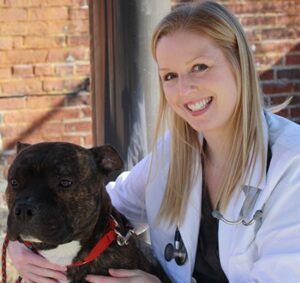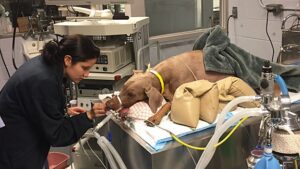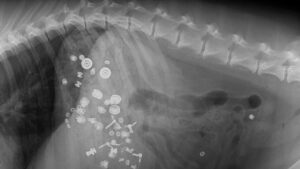-
Adopt
-
Veterinary Care
Services
Client Information
- What to Expect – Angell Boston
- Client Rights and Responsibilities
- Payments / Financial Assistance
- Pharmacy
- Client Policies
- Our Doctors
- Grief Support / Counseling
- Directions and Parking
- Helpful “How-to” Pet Care
Online Payments
Emergency: Boston
Emergency: Waltham
Poison Control Hotline
-
Programs & Resources
- Careers
-
Donate Now
 Jessica Hamilton, DVM
Jessica Hamilton, DVM
www.angell.org/emergency
emergency@angell.org
781-902-8400
MSPCA-Angell West, Waltham
It is a common occurrence for our pets to accidentally ingest something that they shouldn’t, whether it is a medication, toxin, or foreign material. So what do you if this happens to your pet? The first thing that you should do is call your veterinarian’s office or if it is after hours, an emergency veterinary hospital, for further advice about the next steps. If a toxin or medication has been ingested, it may also be necessary to call a poison control hotline such as the ASPCA Animal Poison Control Hotline for further advice about treatment, but the veterinary hospital will direct you to do so if necessary. The Animal Poison Control Hotline has an extensive database and veterinarians on staff 24/7 to help guide you and your veterinarian on diagnostic and treatment recommendations following a toxin or medication ingestion. The majority of the time the Animal Poison Control Hotline will instruct you to bring your pet into a veterinary hospital for evaluation and then based on this and the specific medication/toxin ingestion further recommendations are made.
When you arrive at the veterinary hospital after a known ingestion, your pet will be evaluated by a veterinarian. If there has been a toxin or medication ingestion, then the veterinarian will consult with Animal Poison Control regarding further diagnostics and treatments and potential side effects expected. If there has been an ingestion of some type of foreign material, then taking an abdominal radiograph (or x-ray) is often recommended to evaluate the abdomen and see if any visible foreign material or an obstruction of the gastrointestinal tract is seen.
If the known ingestion was recent and the foreign material is present only in the stomach then it may be possible to induce vomiting to try to get the pet to bring up the material on their own. If the object is large, corrosive, or abrasive in any way or the pet is a brachycephalic breed (short nosed breed, like a bulldog) then it may not be recommended to induce vomiting. In cats we do not have very effective medications for the induction of vomiting so this is less commonly done in in cats. Alternatively, an endoscopy (passing a flexible camera down the esophagus into the stomach) may be possible to attempt to remove the foreign material, but again only if the object is in the stomach and only if there is minimal food present in the stomach because food in the stomach can interfere with locating and removing the foreign material. The ingested foreign material also must be something that is safe to be removed via endoscopy based on size, shape, and consistency. However, even when endoscopy is a viable option for removal of the foreign material, we are sometimes just not able to remove it in this way no matter how hard we try. If this is the case then the patient must ultimately go to surgery to have the foreign material removed. In occasional cases, we will wait to see if the patient will pass the foreign material on their own.
If the ingested foreign material is present in both the stomach and small intestines or there is an obstructive pattern (suggesting a blockage) seen on the abdominal x-rays, then surgery is needed to remove it and/or relieve the obstruction if present. Most of the time, the foreign material can be removed via an incision in the affected area of the gastrointestinal tract, called a gastrotomy (if the incision is into the stomach) or enterotomy (if the incision is into the intestine). Occasionally there is significant damage to the small intestines and it is necessary to remove the damaged portion of the intestine and then suture the two healthy pieces of intestine together, called a resection and anastomosis or R & A. Very rarely the ingestion of foreign material can result in perforation of the gastrointestinal tract and leakage of intestinal contents into the abdomen, thus resulting in infection in the abdomen cavity, called a septic abdomen. A septic abdomen is a very serious condition and if it is present then the prognosis for recovery decreases and the recovery time in hospital is much longer.
Most pets that have surgery to have foreign material removed from the gastrointestinal tract stay in the hospital for monitoring and supportive care for approximately 36- 48 hours after surgery. Prior to being discharged, the pet should be eating well with no signs of nausea, on oral medications, and comfortable on the pain medication regime they will be on at home. At home the pet will be on medications for pain and nausea, sometimes a special diet, and will need to have their activity restricted until the sutures are removed from their abdominal incision. The sutures can be removed 10-14 days following surgery, after which the pet can resume his or her normal lifestyle. In the first days after discharge there is a risk of dehiscence (opening up) of the incision that was made in the gastrointestinal tract, which results in a septic abdomen and a need for a repeat abdominal surgery. It is important to watch your pet carefully at home for loss of appetite, nausea, vomiting, lethargy, etc as these could be signs of a complication.
So what is the take home message about foreign ingestions? If your pet ingests something that it shouldn’t, the first thing that you should do is call your veterinarian. This article gives some information on what to expect and a rough guideline of things that may or may not need to be done to help your pet. But really our goal as veterinarians and owners is to prevent these situations from ever occurring as they result in added stress for both owners and pets alike. So take a few moments when you get home tonight to evaluate your home for potential hazards to your pet (chemicals, toxins, open trash cans, compost piles, human medications, etc.) and to inspect your pet’s toys and bedding to make sure that none are ripped, torn or could pose a high risk for being ingested. If any potential hazards are found then you are able to make changes to prevent a potential ingestion. Taking these steps may save you a call and trip to your veterinarian’s office and more importantly could save your pet’s life.
For more information on the MSPCA-Angell West Emergency Service, please visit www.angell.org/emergency or call 781-902-8400.

